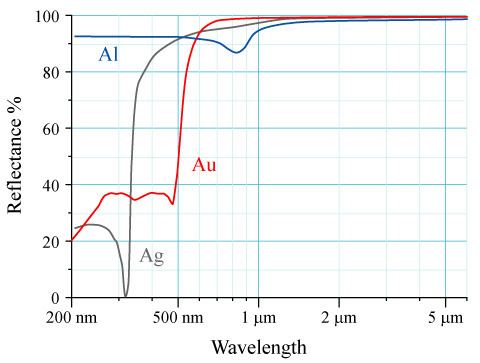 | ||
Reflectance of the surface of a material is its effectiveness in reflecting radiant energy. It is the fraction of incident electromagnetic power that is reflected at an interface. The reflectance spectrum or spectral reflectance curve is the plot of the reflectance as a function of wavelength.
Contents
Hemispherical reflectance
Hemispherical reflectance of a surface, denoted R, is defined as
where
Spectral hemispherical reflectance
Spectral hemispherical reflectance in frequency and spectral hemispherical reflectance in wavelength of a surface, denoted Rν and Rλ respectively, are defined as
where
Directional reflectance
Directional reflectance of a surface, denoted RΩ, is defined as
where
Spectral directional reflectance
Spectral directional reflectance in frequency and spectral directional reflectance in wavelength of a surface, denoted RΩ,ν and RΩ,λ respectively, are defined as
where
Reflectivity
For homogeneous and semi-infinite (see halfspace) materials, reflectivity is the same as reflectance. Reflectivity is the square of the magnitude of the Fresnel reflection coefficient, which is the ratio of the reflected to incident electric field; as such the reflection coefficient can be expressed as a complex number as determined by the Fresnel equations for a single layer, whereas the reflectance is always a positive real number.
For layered and finite media, according to the CIE, reflectivity is distinguished from reflectance by the fact that reflectivity is a value that applies to thick reflecting objects. When reflection occurs from thin layers of material, internal reflection effects can cause the reflectance to vary with surface thickness. Reflectivity is the limit value of reflectance as the sample becomes thick; it is the intrinsic reflectance of the surface, hence irrespective of other parameters such as the reflectance of the rear surface. Another way to interpret this is that the reflectance is the fraction of electromagnetic power reflected from a specific sample, while reflectivity is a property of the material itself, which would be measured on a perfect machine if the material filled half of all space.
Surface type
Going back to the fact that reflectance is a directional property, most surfaces can be divided into those that give specular reflection and those that give diffuse reflection:
Most real objects have some mixture of diffuse and specular reflective properties.
Water reflectance
Reflection occurs when light moves from a medium with one index of refraction into a second medium with a different index of refraction.
Specular reflection from a body of water is calculated by the Fresnel equations. Fresnel reflection is directional and therefore does not contribute significantly to albedo which is primarily diffuse reflection.
A real water surface may be wavy. Reflectance assuming a flat surface as given by the Fresnel equations can be adjusted to account for waviness.
Grating efficiency
The generalization of reflectance to a diffraction grating, which disperses light by wavelength, is called diffraction efficiency.
Applications
Reflectance is an important concept in the fields of optics, solar thermal energy, telecommunication and radar.
